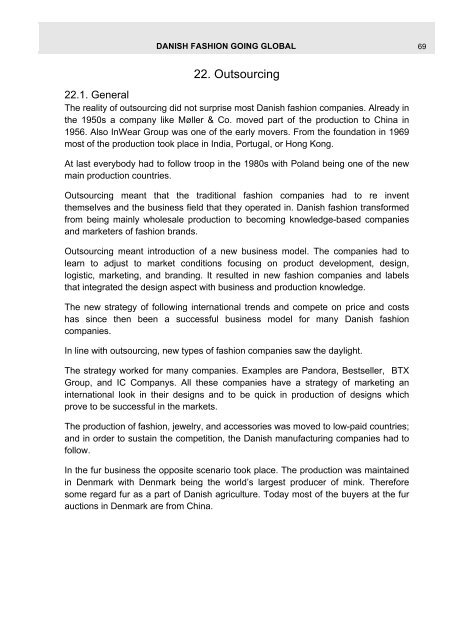Danish Fashion Going Global - Spandet And Partners
Danish Fashion Going Global - Spandet And Partners
Danish Fashion Going Global - Spandet And Partners
You also want an ePaper? Increase the reach of your titles
YUMPU automatically turns print PDFs into web optimized ePapers that Google loves.
DANISH FASHION GOING GLOBAL 69<br />
22. Outsourcing<br />
22.1. General<br />
The reality of outsourcing did not surprise most <strong>Danish</strong> fashion companies. Already in<br />
the 1950s a company like Møller & Co. moved part of the production to China in<br />
1956. Also InWear Group was one of the early movers. From the foundation in 1969<br />
most of the production took place in India, Portugal, or Hong Kong.<br />
At last everybody had to follow troop in the 1980s with Poland being one of the new<br />
main production countries.<br />
Outsourcing meant that the traditional fashion companies had to re invent<br />
themselves and the business field that they operated in. <strong>Danish</strong> fashion transformed<br />
from being mainly wholesale production to becoming knowledge-based companies<br />
and marketers of fashion brands.<br />
Outsourcing meant introduction of a new business model. The companies had to<br />
learn to adjust to market conditions focusing on product development, design,<br />
logistic, marketing, and branding. It resulted in new fashion companies and labels<br />
that integrated the design aspect with business and production knowledge.<br />
The new strategy of following international trends and compete on price and costs<br />
has since then been a successful business model for many <strong>Danish</strong> fashion<br />
companies.<br />
In line with outsourcing, new types of fashion companies saw the daylight.<br />
The strategy worked for many companies. Examples are Pandora, Bestseller, BTX<br />
Group, and IC Companys. All these companies have a strategy of marketing an<br />
international look in their designs and to be quick in production of designs which<br />
prove to be successful in the markets.<br />
The production of fashion, jewelry, and accessories was moved to low-paid countries;<br />
and in order to sustain the competition, the <strong>Danish</strong> manufacturing companies had to<br />
follow.<br />
In the fur business the opposite scenario took place. The production was maintained<br />
in Denmark with Denmark being the world’s largest producer of mink. Therefore<br />
some regard fur as a part of <strong>Danish</strong> agriculture. Today most of the buyers at the fur<br />
auctions in Denmark are from China.


